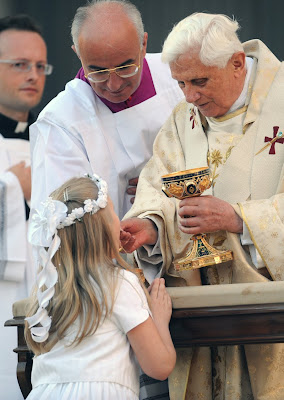
A reader:
"I know this may seem a bit odd, but I was hoping to get your perspective on the U.S. GIRM 160, which states: "The norm for reception of holy Communion in the dioceses of the United States is standing. Communicants should not be denied holy Communion because they kneel. Rather, such instances should be addressed pastorally, by providing the faithful with proper catechesis on the reasons for this norm."Father Z replies:
There are people, including the popular and much visited website, Catholic Answers who have spoken that kneeling for communion is inappropriate as it goes against the norm in the United States, and that one is disobedient if one still chooses to kneel even after having been "pastorally" corrected as to the proper norm in the country.
Can you provide further clarification according to your knowledge as to whether or not it is "licit" for one to kneel in the U.S. even though it may not be the U.S. norm, and whether or not one is disobedient after being "pastorally" corrected according to U.S. GIRM 160."
"Since this veered into the technical, I consulted a canon lawyer before answering. I will adapt his response with my own.
Part of a response must involve what "norm" means. I admit that I use the term "norm" rather loosely when writing and talking, and often morph it into "laws", and vice versa.
A norm is not the same as a law.
The "norm" for the U.S., in accordance with GIRM 160, is that communicants stand when receiving Holy Communion.
 One thing we have learned from post-modernists, is also to read a text for what it doesn’t say. GIRM 160 doesn’t say, "In the United States, Holy Communion must be received while standing." That would be a disciplinary liturgical law. It would require a dispensation to do something different (i.e., to kneel).
One thing we have learned from post-modernists, is also to read a text for what it doesn’t say. GIRM 160 doesn’t say, "In the United States, Holy Communion must be received while standing." That would be a disciplinary liturgical law. It would require a dispensation to do something different (i.e., to kneel). Rather, GIRM 160 in the USA is a norm. That is to say it points to a normative thing, the usual practice, the custom. In 25 years we can have a discussion on what legal force this custom has, but now is not the time.
What the U.S. bishops did in including this norm, with the approval of the Holy See, is state that the normal manner of receiving Holy Communion, in the United States, is standing. The usual way… it is customary now.
The addition of the second statement (communicants "should not be denied Holy Communion because they kneel") shows that the norm is not some sort of enforceable law.
The situation is to be addressed "pastorally", with explanations, catechesis, etc. Once people have been provided with this, if they chose to continue to kneel they are not being disobedient. They do not do something illicit. They have chosen to follow a practice that differs from the norm. That does not violate a law..."

No comments:
Post a Comment